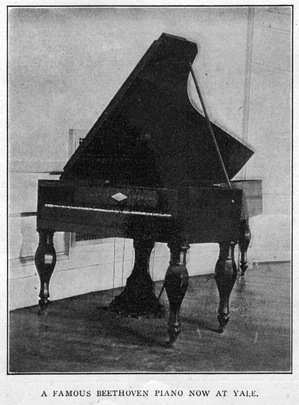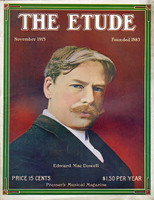Though most of the instruments of the large Steinert collection, now to be seen in the Memorial Hall of Yale University, are older and quainter, without and within, the lover of music lingers longest over the piano which is said to have belonged to and was doubtless used by Beethoven.
Except for its lightness, this grand piano looks not unlike our modern instruments, and indeed, save for volume of tone, it is not so very far removed from the pianos of our own time. It has a keyboard of six and a half octaves with three strings for each note, except in the lowest octave where there are two. There is no sign of a music rack, but there is a goodly supply of pedals, for there are five—three “soft” pedals, one of which shifts the keyboard so that the hammers strike two strings, another that shifts the keyboard until one string alone was struck, and one that drew a piece of felt between the hammers and the wires. There is the usual damper-lifting loud pedal, and a pedal which draws a folded piece of paper down upon the strings of the lower octaves of the instrument. This “bassoon” pedal produced an effect similar to the mandolin pedal of our modern instruments and doubtless was little used by the great composer.

Andreas Stein, Nanette’s father, was the founder of a large branch of German piano making. He invented the shift of the keyboard still used in the soft pedals of our grand pianos, and made other important improvements of the action. Nanette was born a year before Beethoven. She played before Mozart at eight years of age. Her father instructed her at an early age in the details of piano making, and on his death in 1792 she “carried on his business, in conjunction with her brother, with a decision and energy almost masculine.” In 1793 she married Johann Andreas Streicher, a friend and schoolmate of Schiller, and moved the piano factory to Vienna.
Beethoven had used the Stein piano in Bonn, and doubtless the Streicher became his favorite, for it had more than the friendship of Nanette to recommend it. We do not know when this friendship began, but it was in 1813 that Frau Streicher seems to have taken an active interest in his domestic affairs. She followed him to Baden, whence he had gone for his health in 1813, and took charge of his lodgings, managed his servants and kept his clothes in order. She also was his source of sympathy and advice over his tangled household affairs after his return to Vienna, and added greatly to the comfort of the composer for a number - of years.
This piano of the Yale museum is said to have been used by Beethoven at Baden, though certainly not on his first visit there. It is likely that Madame Streicher kept it at his disposal wherever and whenever he felt like using it, and it is probable that many of his later compositions were played upon it for the first time. We know that Beethoven used other pianos, for in December 1817, Mr. Broadwood presented him with one, and Graf, of Vienna, also made for him in his last years, one having four strings to the note, in the hope that his damaged organs of hearing might be able to appreciate the larger volume of tone thus produced.



